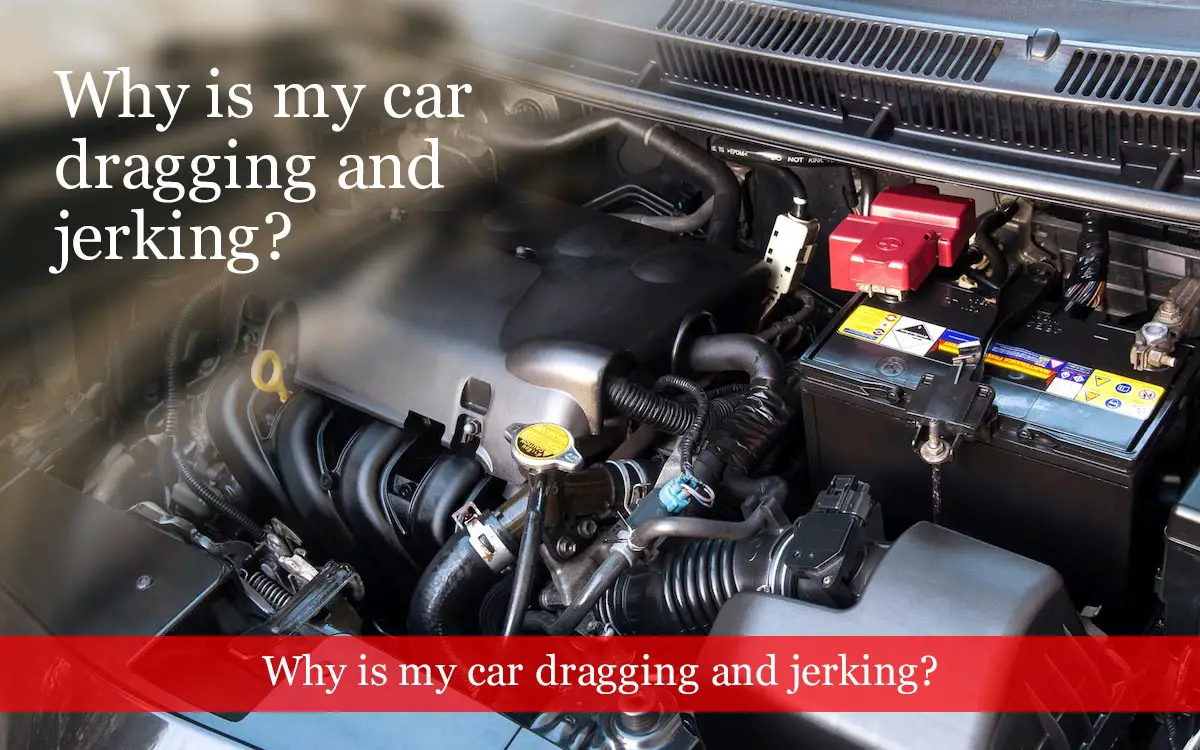Does your car feel like it’s constantly jerking and dragging as you’re driving? If so, you’re not alone. For many people, finding out why their car is acting this way can be a real mystery – but there are some potential causes that might lead to the jerking and dragging such as low transmission fluid, work spark plugs, dry or dirty air filter, malfunctioning components, dirty gas lines and a lot more.
In this article, we’ll take a look at possible explanations of these causes and discuss how best you can solve this issue because if you leave it unchecked it can lead to more serious issues down the line.
Let’s get started on solving the mystery of what’s making your car drag and jerk!
Reasons Why Your Car is Jerking or Dragging
As mentioned above, there are various reasons why your car might be jerking or dragging. Let’s look at some of the more common causes:
- Low transmission fluid
- Worn spark plugs
- Clogged fuel filter
- Damaged gas Lines
- Malfunctioning brakes
- Faulty oxygen sensor
- Dirty air filter
- Malfunctioning oxygen sensor
- Faulty muffler
- Defective carburettors
Let’s discuss these in detail:
1. Low Transmission Fluid
The first and probably the most common cause of jerking and dragging is low transmission fluid. Transmission fluid helps lubricate the gears and various parts of your car’s transmission, as well as regulate its temperature.
If you are low on transmission fluid, it causes friction between the parts, which in turn causes a jerking and dragging sensation. To avoid this, make sure you regularly check the transmission fluid levels in your car and top off as needed!
Remember to use the exact same transmission fluid that your car manufacturer recommends and don’t settle for generic alternatives.
2. Worn Spark Plugs
Another common cause of jerking and dragging is worn spark plugs. Spark plugs are responsible for igniting the fuel in your engine, which helps get your car moving. If the spark plugs on your car are worn, they won’t be able to ignite the fuel as effectively and this will lead to a jerking and dragging sensation.
It’s easy to check your spark plugs – just pop open the hood of your car and take a look! If they are worn, it’s best to replace them with new ones as soon as possible.
3. Clogged Fuel Filter
Another possible cause of jerking and dragging is a clogged fuel filter. You might not think a fuel filter gets clogged because fuel looks clean, but over time dirt and debris can accumulate in the fuel filter and cause blockages.
A fuel filter helps remove any debris and dirt from the fuel before it gets to your engine and when clogged can restrict the flow of fuel to your engine, which can lead to a jerking and dragging sensation because the engine isn’t getting enough fuel to run smoothly.
To prevent this issue, it’s important to regularly replace your fuel filter as recommended by your car manufacturer. This will ensure that your engine is getting clean and sufficient fuel for optimal performance.
In addition, it’s also a good idea to use high quality gasoline and avoid using low grade or contaminated gas from unreliable sources. This can also help prevent clogs in your fuel filter and keep your engine running smoothly.
4. Damaged Gas Lines
Damaged gas lines are a result of corrosion and wear-and-tear over time. If you suspect that your gas lines are damaged, it’s best to have a professional take a look as soon as possible. Gas lines are damaged by rust, cracks or holes and when this happens, the fuel supply to your engine can become restricted. This restriction can cause a decrease in fuel pressure which leads to jerking and dragging.
To avoid damage to your gas lines, it’s important to regularly inspect them for any signs of corrosion or wear-and-tear. I will also recommend you have them replaced at least every five years or as recommended by your car manufacturer. This will ensure that your engine continues to receive an adequate supply of fuel and prevent any major damage to your gas lines.
If you notice any strange smells, leaks or noises coming from your gas lines, it’s important to address the issue immediately. Ignoring these warning signs can lead to a potential fire hazard and put you and your vehicle at risk.
5. Malfunctioning Brakes
Also, if your car’s brakes are not working properly, it could cause a jerking and dragging sensation. Brakes help slow down and stop the car, so if they aren’t functioning correctly, they won’t be able to do their job.
I would say brakes are one of the most important parts of a car, so it’s important to check your car’s brakes regularly and replace or adjust them if needed.
I would also advise you not to temper with the brakes yourself unless you are qualified to do so, as it is a delicate process that requires knowledge and skills. The slightest mistake you make can lead to further problems down the road.
It’s also important to check your car’s brake fluid levels regularly. Low brake fluid can cause the brakes to malfunction and cause jerking and dragging sensations when driving. Replacing the old brake fluid with new brake fluid can help ensure that your car’s brakes are working properly and not causing any jerking and dragging sensations.
6. Faulty Oxygen Sensor
Again, a faulty oxygen sensor can cause jerking and dragging sensations when driving. The oxygen sensor is responsible for maintaining the optimal air-fuel ratio in your engine, which helps keep it running smoothly. If the oxygen sensor is faulty, it won’t be able to do its job.
Oxygen sensor problems are caused by age, dirt and debris buildup, or even fuel contamination. If you suspect that your oxygen sensor is the cause of the jerking and dragging, make sure to have a professional check it out as soon as possible.
7. Dirty air filter
A dirty air filter can also cause jerking and dragging sensations when you drive. The air filter is responsible for filtering out dirt, dust, and other debris from the air that’s entering your car’s engine, so it doesn’t get clogged up with debris. If the air filter isn’t changed regularly or gets too clogged up, it won’t be able to do its job and can cause your engine to run poorly.
It’s important to change the air filter regularly to ensure that your car is running at optimal performance. It’s also a good idea to inspect the air filter for dirt, dust, and other debris buildup periodically. If you notice an excessive build-up of debris, it’s best to replace the air filter.
8. Faulty Muffler
A muffler is responsible for reducing the amount of noise your engine makes when running. If it’s not working properly, it can cause jerking and dragging sensations when driving. Faulty mufflers usually have a hole or crack in them that allows exhaust gases to escape, which can cause jerking and dragging sensations.
To check for a faulty muffler, look under the car for any signs of a hole or crack. If you find one, it’s best to have a professional check it out and replace the muffler as soon as possible.
9. Defective Carburettors
A defective carburettor can also cause jerking and dragging while driving. The carburettor is responsible for mixing the right amount of air and fuel to power your engine. If it’s not working correctly, it can cause the car to run rough or experience stalling.
Signs of a defective carburettor include difficulty starting the car, poor acceleration, and reduced fuel economy. If you notice any of these signs, it’s best to have a professional inspect and repair the carburettor. Regular maintenance and cleaning can also help prevent issues with your carburettor.
10. Transmission Problems
Lastly, If your car is experiencing jerking and dragging while shifting gears, it could be a sign of transmission problems. The transmission is responsible for transferring power from the engine to the wheels, so any issues with it can affect how your car runs. If you notice jerking or dragging specifically while shifting gears, it could be a sign of low transmission fluid or worn-out transmission components.
It’s important to have your transmission checked and serviced regularly to ensure it is functioning properly. This can help prevent more serious and expensive issues in the long run.
If you do experience jerking and dragging due to transmission problems, it’s best to take your car to a mechanic for diagnosis and repair. Attempting to fix transmission issues on your own can be dangerous and may cause further damage to your car.
Final Thoughts
I would conclude by saying that jerking and dragging sensations while driving can be caused by various factors ranging from simple maintenance issues to more serious mechanical problems.
It’s important to regularly inspect and maintain your vehicle to avoid these issues and ensure a safe driving experience. If you notice any unusual sensations or sounds while driving, it’s best to have a professional mechanic inspect and repair your car as soon as possible.
By taking proper care of your vehicle, you can prevent costly repairs and keep your car running smoothly for years to come. Remember, a well-maintained car means a safer and more enjoyable driving experience for you and your passengers. So, don’t ignore any signs of problems and address them promptly to keep your car in top condition.
Drive safe! So, don’t ignore any signs of problems and address them promptly to keep your car in top condition.

